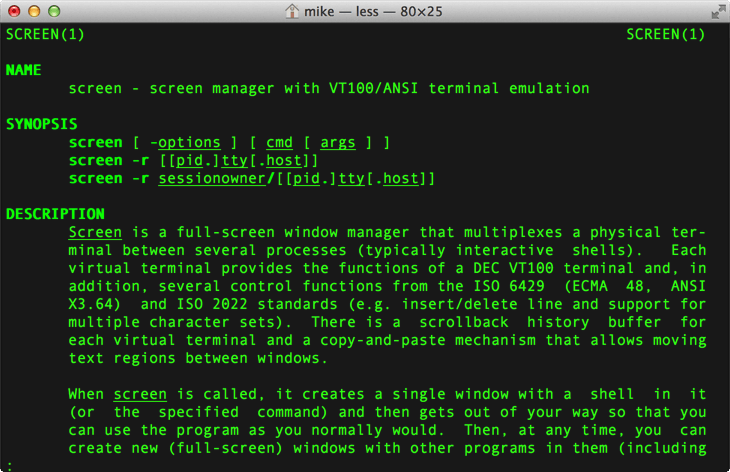Tiny TTY Mac OS
Using screen as a serial terminal on Mac OS X
Geek Inc.Mac OS High Sierra (macOS 10.13). As the new name suggests, it’s just a refinement of last year’s Mac OS Sierra. In fact, you could sum up what's new in an article about as short as this one. A tiny framework for easily manipulate the tty and create fake binaries.
If you develop on an Apple and find yourself doing any sort of device or embedded development, you will quickly find the need for a serial terminal on Mac. There are a few software apps out there, but I find it much simpler to simply use the terminal application “screen”.
This works well particularly if you have an RS-232 serial to USB converter.
The first thing to do is determine which device you want to connect to.
Mac Os Download
Once you’ve determined which device you would like to use, you can execute the SCREEN command to start the serial terminal session on your Mac. Remember to specify the speed (baud rate) after the device name.
Once you’ve connected, you can use the terminal as you normally would.
To exit (and close the screen gracefully) press:
Screen will then prompt you to quit and kill all of your windows. Press “y” and you’ll be back to your shell terminal.
This method works equally well if you want to connect to a serial bluetooth device. You must simply make sure that the bluetooth device is paired and active. Then you will be able to see the device in the list of devices. Once you’ve connected to the serial bluetooth device with screen, the connection will be held active for the length of your session.
I’ve used this method to connect to the sparkfun Bluetooth Mate Gold. It simply appears as a serial stream that you can communicate with exactly as you would with any other serial device.
In the United States, you can make and receive RTT calls on Mac models introduced in 2012 or later (excluding Mac Pro) after updating to macOS Mojave 10.14.2 or later. You also need an iPhone with a carrier plan from AT&T, T-Mobile, or Verizon. Standard voice call rates apply for RTT calls.
You can make and receive RTT calls on your iPhone as well.
How to set up RTT
- Set up Wi-Fi calling on your iPhone, making sure to add your Mac as one of the other devices to be used for Wi-Fi calling.
- On your Mac, choose Apple menu > System Preferences, then click Accessibility.
- Select RTT in the sidebar. It appears only when Wi-Fi calling is set up correctly.
- Select Enable RTT.
- To send characters as you type them, select Send Immediately.
- Enter the U.S. RTT relay number: 711.
How to make an RTT call
- Your Mac uses FaceTime for RTT calls, but you can start the call from either Contacts or FaceTime.
- In Contacts, move your pointer over a contact's phone number, then click the the RTT button next to the number.
- In FaceTime, click the audio button next to the contact or after entering a phone number. Then choose RTT Call or RTT Relay Call from the pop-up menu.
- When the call is answered, click RTT to begin exchanging text messages in real time. While texting, you can also speak through your microphone, if available, or click Mute to mute your microphone.
- Type your message, then press Return or click the send arrow to send it. If Send Immediately is turned on in RTT preferences, the other person sees your message as you type it.
- To hide your conversation, click RTT. While the conversation is hidden, you won't see messages the other person sends you. Click the button again to return to the conversation.
How to answer an RTT call
When you receive a call on your Mac, click Accept to answer it. Then click RTT to begin exchanging text messages in real time.
How to end an RTT call
Tiny Tty Mac Os X

Learn more
- VoiceOver doesn't announce new RTT messages on Mac, so you should follow the conversation in the RTT window.
- Some carriers might disconnect the RTT call if no RTT messages have been exchanged for over 3 minutes.
RTT and TTY aren't supported by all carriers or in all regions. RTT and TTY functionality depends on your carrier and network environment. When making an emergency call in the United States, iPhone sends special characters or tones to alert the operator. The operator's ability to receive or respond to these tones can vary depending on your location. Apple doesn't guarantee that the operator will be able to receive or respond to an RTT or TTY call.